Contributed By
Published
Robert Frazer discusses an early build of Panzer Dragoon. Disclaimer: some facts in this article have been disputed and may be inaccurate.
Thanks to Lance Way for making many suggestions and comments about this article’s content.
Contents
- Introduction
- Enter the Dragon
- The Emerald Dragon - The Panzer Dragoon pre-alpha
- Dawn of an Era
- Postscript: From Beyond the Grave
- Bibliography
Introduction
When we marvel at Panzer Dragoon and many other computer games - our engrossment in solving puzzles, appreciating the intricate weave of a multifaceted plot, or (more frequently) blasting the latest upsurge of 73|-| 3\/1|_ ()|\|35 back to the Twelfth Gulf of Perdition, it’s easy to forget about the tremendous amount of effort that is invested into the creation of these sources of gaming gratification (well, unless you work for Electronic Arts or Sony).
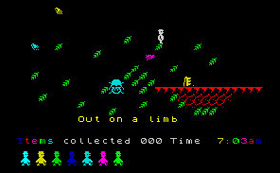
The Atari 2600, the lead machine of the company which reigned as the dominant power in the Console Wars until the infamous, ignoble and ignominious shambles that was the Crash of ‘83 (yes, there are aliens in Nevada - but they’re thousands upon thousands of copies of the dismal, rushed E.T. languishing at the bottom of a spoil heap.), was infamous for its appallingly limited memory (an emaciated 4 kilobytes) which made it a nightmare to program (“Some people climb Everest. Some swim across the English Channel. And others write Atari 2600 games” was the wry comment applied to the machine in Issue Twelve of the U.K. Retro Gamer magazine). Over two decades later, the situation remains very much the same, with dozens of programmers shackled to their workstations and whipped relentlessly through months or even years of painstakingly tapping out reams of incomprehensible script for even relatively simple titles.
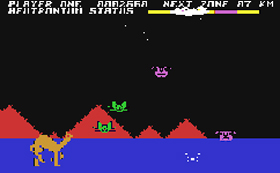
Yet games now can no longer be defined simply by gruelling labour with machine code or BASIC for weeks on end. As games have mushroomed in complexity, so have the staff and commitment required to generate a satisfactory product. The era when individuals with a single spark of ingenuity could craft a game, such as Matthew Smith (Manic Miner; Jet Set Willy) or Jeff Minter (who, trading under the title of Llamasoft, was responsible for such distinguished and distinctive titles as Hover Bovver [a really rather good… lawnmower simulator!], Tempest and Revenge of the Mutant Camels) and enjoy commercial success with them is long past. Indeed, Jeff Minter’s recent endeavours to re-enter gaming with his ‘Unity’ collaboration with Lionhead and Tempest 3000 for the Nuon DVD Player-Games Console hybrid were miscarried and stillborn respectively. You’ve never heard of the Nuon machine? Exactly…
Sega, the creators of Panzer Dragoon, are no exception to this trend - for instance, we commonly attribute the sensational Sonic the Hedgehog to the sole vision of the great and celebrated Yuji Naka, but even he was one member of a team of fifteen and the memorable Blue Blur himself and much of his colourful world was the product of the imagination of Naoto Oshima.
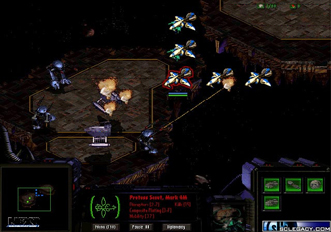
One of the consequences of enlarged development teams is, of course, development by committee. Almost all games now can be expected to warp, alter, and change to at least some extent in the time period between when a new title is first mooted in an afternoon board meeting to the period when the scintillating Gold Disc is ferried to the manufacturers to be pressed en masse for shipment. To my mind, nowhere is this more evident than the famous Starcraft of Blizzard Entertainment, what many consider - with considerable justification - to be the apogee of the real-time strategy genre. This game mutated virtually beyond all conceivable recognition from the diminutive “Warcraft in Space” of E3 1996 to the chart-busting titan of 1998 - its development is well-charted at a major fansite, Starcraft Legacy. Sega was no stranger to such contorted and twisted development wrangles and the evolution or debasement of concepts either - it may be difficult now to imagine him as anything else, but Sonic the Hedgehog was once Sonic the Armadillo, Squirrel, Bulldog, Wolf and Rabbit.
Altogether, it’s astounding that you can still enter the doors of any games company - the buildings should have collapsed underneath the spine-crushing weight of all that accumulated material on the cutting-room floor long ago!
Enter the Dragon
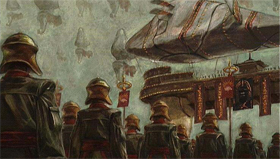
Now, I understand that many of you will be wondering what relevance my vague meanderings on computer-game history have to the magnificent Panzer Dragoon, and I shall explain.
One of the most attractive aspects of the four major Panzer titles that form the series (as it stands today, at least - never cease praying for another game!), and one most advertised by the series’ fans, is its distinctive and highly individual art style.
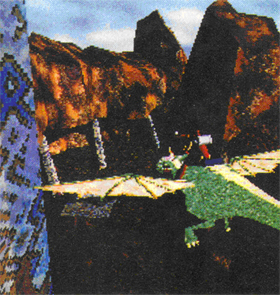
One would expect such unique and decidedly individual aesthetics (the original game was even commended by Steven Spielberg!) to have been the product of a single, determined, irrepressible, driving vision, for it’s well-known that co-operation and consultation in committees almost invariably results in neutralisation - all manner of extremes and wildly different opinions and ideas are obliged to be constant, and so they coalesce into bland homogeneity. As much as we’d expect the innovative creators of Panzer Dragoon to defiantly and vigorously cast off this crippling convention of compromise, surprisingly this doesn’t seem to be so - indeed, evidence suggests that the world of Panzer Dragoon was to be depicted in a shockingly and disturbingly dull fashion. And who is the harbinger of such a harrowing suggestion? The unkempt agglomeration of polygons I have dubbed the Emerald Dragon.
The Emerald Dragon - The Panzer Dragoon pre-alpha
(N.B.1 - The dragon in these images has no official name. I refer to him as “The Emerald Dragon” for the sake of convenience, his colour, and the fact that it sounds more imposing and so helps to redeem a highly un-Panzerish model…)
(N.B. 2 - For those unaware, “Eins” refers to the first released Panzer Dragoon game.)
The dire Panzer dystopia of which I speak was first displayed at the January 1994 Consumer Electronics Show (CES) in Las Vegas, where Sega’s presentation treated those who attended to the first publicly-demonstrated footage of the prototype Saturn in action. When reviewing the images released it is quite patently evident that ‘3D’ was the new buzzword in the computer games industry - in addition to Virtua Fighter and Virtua Racing, all of the Saturn demos had those alluring symbols emblazoned on their titles. Clockwork Knight was known as 3D Action Game, and (although it wasn’t shown at CES and didn’t emerge until some time later) the battlemech game Gungriffon was developed under the working title of 3D Polygon. And then the UK Official Sega Magazine (the source from which I draw all of the pictures of the Emerald Dragon provided in this section) duly reported a rolling demo that was given the unassuming title of 3D Shooting Game - and one that bears more than a passing resemblance to a series that this website is dedicated to…
Unfortunately, the photographs of the demo that the Official Sega Magazine provided were extremely grainy, and if they were condensed to fit into the dimensions of this webpage distinguishing details in them would be virtually impossible - as such, I have taken enlarged scans of the relevant images and placed links to them here - I will refer to relevant images in the text itself.
- Official Sega Magazine Issue #6 (1 of 1)
- Official Sega Magazine Issue #7 (1 of 2)
- Official Sega Magazine Issue #7 (2 of 2)
As these images of the preliminary game demonstrate, the first conceptions of Panzer Dragoon are disturbingly unfamiliar to the products as we understand them today. The rolling demo itself displays a scene with a mounted dragon (although of a decidedly more conventional type than Lagi) flying through a rocky valley, decorated with some buildings and a few airborne monsters (although the appallingly low resolution makes it difficult to distinguish what sort of creatures they are, guided by the OSM caption writer describing one as a “nasty flying insect type” in Image 1 I can only suggest that they are some sort of oversized hornet - judge for yourself in the central panels to Image 2, and the bottom of Image 3).
Evidence for the fear that Panzer Dragoon might not have evolved from being a very basic game is witnessed in the abnormality that is the Emerald Dragon. Unlike the artful and graceful creature that sheened across our televisions in Eins, the Emerald Dragon is much, much blander and far more like the cliched and conventional image of a dragon. It is a bulky, scaly beast, wholly unlike the sleek dart the seethes through the air in the full games, and so this demo conveys little sense of awe or astonishment. The dragon’s weapons also seem more mired in conventional fantasy - the rider (who seems to be riding on a normal saddle, suggesting that the Emerald Dragon is a tamed beast, different from the intimate mental link with wild, unsuppressed energy shown by the bareback riders in the games) is equipped with a crossbow rather than the famous laser gun, and instead of the elegant and deadly Arrows of Light the Emerald Dragon retches up a coagulated ball of photonic sputum (it’s difficult to tell whether this energy originates from the dragon or the crossbow) - which, despite having a tenuous link with the energy-based Arrows of Light, is more in keeping with a fireball…
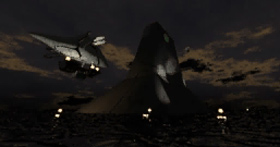
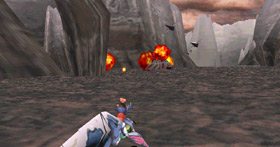
The world which the Emerald Dragon bumbles through is also highly unrefined and a complete paradigm shift from the sophisticated nature of Panzer Dragoon. Image 2 shows this most clearly in the central images - see how the buildings are more of a dull grey battlemented castle, a generic imposing design that differs wildly from the hardy, practical wasteland encampments, tribal wefts and weird unnatural constructs that feature throughout Panzer Dragoon. We have no inkling either of the blasted wastelands from the demo’s canyon - indeed, the streaks of green distinguishable on the rock suggest that the environment was first intended to be fairly lush and fertile. By complete contrast, Eins’s opening cinematic commenced against a backdrop of a mucky, rusty sky and transferred to an arid, empty desert; Zwei’s first two episodes were a shattered, smoldering ruin of a settlement and a canyon (but a harsh, abrasive, ashen one) respectively; Saga showed men chipping away at the residue of a bygone era of prosperity - and being attacked by it; We first see the protagonist of Orta bound by cruel shackles and her head wrapped in a fur as if to guard against a bitter, unwelcoming cold. I admit that this demo was a very early build when the very Saturn itself was still in development, and so you can’t expect a great deal of depth, but there does not even appear to be the ambition to construct the evocative environment that we’ve come to appreciate in the games. Quite disappointing.
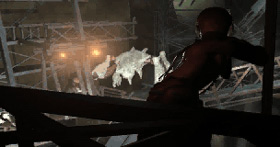
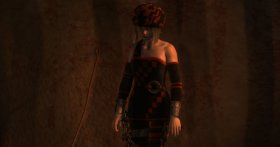
What is even more harrowing is that this demo may have been all that we would have witnessed of the grand Panzer Dragoon universe. Despite this demo being called 3D Shooting Game, both the developers that Sega Magazine interviewed and their own comments seemed more preoccupied with gawping over texture-mapping, light-sourcing, gouraud shading and multiple viewpoints than discussing how the title could be expected to develop. Apparently, according to Sega Magazine, “this game shows off what the Hitachi SH2 RISC processors as used in Mega-32 [later the 32X] and Saturn) are really capable of doing”. This game was no more than a technical demo! For fans of the series who regularly exclaim about the marvelous depth to the games, to know that it began life as something that is intentionally shallow must be quite a shock.
Then, abruptly, everything changed. A scant couple of months later, Sega Magazine were touting pictures of a new game - Panzer Dragoon. And, as the text seen in Image 4 demonstrates, this was a direct evolution of the concept of the maligned 3D Shooting Game. Although we are of course thankful that the game evolved for the undoubted better, this doesn’t remove the insistent question - what caused such a change of heart in the developers?
Dawn of an Era
The answer may seem to be an obvious one - 3D Shooting Game wasn’t just a technical demo, and Sega Magazine misinterpreted it as such due to the early stage of development where only the physics engine was operational. Sega Magazine itself says in the accompanying text to the screenshots in Image 2 that:
First of all, there has still been no indication of just how far this project will progress. Although it has been called a game, the work-in-progress version we’ve seen is little more than a graphical demo…
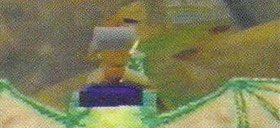
As you can infer from this text, Sega Magazine itself was far from conclusive over what 3D Shooting Game actually was. There are additional parallels between the demo and the full game which reinforce a sense of continuity - the alterable viewpoints survived into Eins (and in both versions the side and rear views were first-person), and curiously so did an element of the graphics - if you compare the decoration on the pillar at the end of the “Enter the Dragon” section above to the screenshot left, it appears that vaguely similar texturing was used - perhaps the same artists who developed the demo also worked on the complete version of Panzer Dragoon?
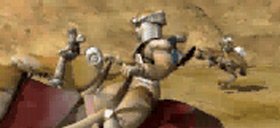
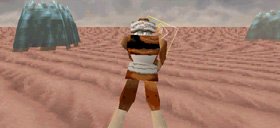
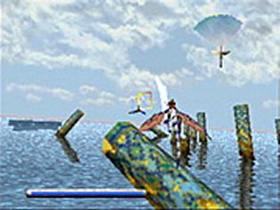
Further suggestions of this consistency can be found in the demo - for instance, although the monoshaded nature of the character models’ polygons in 3D Shooting Game renders it difficult to distinguish, the protagonists of both it and Eins seem to be stylised as roving adventurers or hunters. The brown texture of the demo dragonrider suggests hardy, hooded travelling clothes (I doubt that Georgio Armani ever includes ‘saving the world with a genetic monstrosity’ as a theme of his sketches, anyway), which link to the Eins screenshots shown here. He is also equipped with a backpack and a crossbow - items Kyle and his companions touted between them in the intro full motion video when they were riding on the khourieats/coolias. This might suggest that both dragonriders are conceptually the same person, or at least follow the same creed.
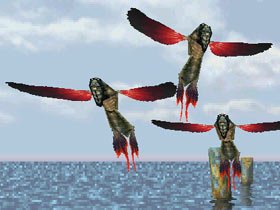
A further link can be seen in the foes that the demo dragonrider has to contend with. Although aggressive oversized insects are a far cry from the silica-like pure-type monsters and the traits of them that endure in their half-breed mutant cousins, they are not incompatible with the Panzer Dragoon world - indeed, the above screenshot shows that the game designers hadn’t rejected the concept of enemies modeled on insects in the transition between the demo and the full game.
If all these factors are so, then a link of continuity is established which confirms that rather than being an unholy debased twin of Panzer Dragoon, the 3D Shooting Game demo was no more than an embryo of a game which had yet to blossom out into its full beauteous scope. The disjointed nature of the graphics between the CES demo and the retail version of Panzer Dragoon can be attributed to the fact that, although in early 1994 little about the game was finalised, Team Andromeda needed at least something workable to show to the industry representatives at CES (unlike the colourful and noisy journalist-fest that is E3, the semi-annual CES shows are more sombre-minded trade fairs), even if it was only barebones practicality instead of high art, to prove to prospective third-party developers that the Saturn’s hardware could manage a wide range of game types (so whilst 3D Shooting Game wasn’t a technical demo per se, its contents could be used as such to attract journalists and developers). Whilst the game world shown at the time was crude, it was just enough to give a rough idea of its concept before the serious refinement into the Panzer Dragoon we cherish today occurred.
A study of the developers’ words themselves seems to add stronger foundations to this conclusion. Gamespot’s study of the origins of Panzer Dragoon reveals some informative excerpts. These show that the team was motivated from the very beginning to intentionally utilise their new hardware to its maximum potential, by specifically creating the unique world we’ve come to know and love:
Takashi Iwade, who worked on the opening CG and character models in the game, recalls that development on the new hardware was a truly unique experience: “Everything was new to us. It was our first experience at trying to create a completely different world and environment, unlike a simulation type of environment you would see in a racing game, with interactive computer graphics.”
…
The game’s natural look was a reaction to the somewhat sterile look of 3D games at the time, which leaned toward straight science fiction. The enemies in the game reflected a variety of disparate influences. “I got inspiration from antique clocks and various industrial products from the era of the industrial revolution for mechanics, and myriapods, marine mollusks, ammonite, and a rusty fishing boat for creatures when I started thinking of the original battleship,” Iwade remembers. As luck would have it, the game’s unique style meshed well with the Saturn hardware’s capabilities. “I carefully made sure that the appearance of enemies would be easy to understand visually, and that they had a simple silhouette, and as a result of this, it matched to the characteristics of Saturn hardware,” Iwade says. “So we had the art style first.”
-and the intention to explore that world fully and comprehensively becomes evident when we know that Saga, the game that unlocked the background to Panzer Dragoon, began development at the same time as the more conventional shooter prequel Zwei.
Alternatively, though, it has been suggested that 3D Shooting Game was no more than the technical demo that was made implicit to the Sega Magazine journalists - the rationale for this hypothesis derives from the thought that as demos such as 3D Shooting Game were so primitive and early, Sega’s development teams had yet to assemble. The group that was eventually to become Team Andromeda, after being given their brief to ‘make some sort of shoot-‘em-up’, chose to evolve the concept of a wholly separate and unrelated demo as source material.
I would reject such a suggestion, however. For one, the words of the designers themselves don’t mention a syllable about them approaching other demos, and they speak of Panzer Dragoon as a continuous, individual project. Furthermore, whilst 3D Shooting Game is nowhere close to completion, several of Sega’s other demos shown at CES - such as Saturn Soccer and 3D Action Game (later Clockwork Knight) were much more advanced and mature. As development teams had been formed specifically for the sole ad hoc purpose of engineering launch titles (such as Aquila for Clockwork Knight; and remember that Team Andromeda disbanded itself when it judged the Panzer cycle to be completed with Saga), why would their time of formation be inefficiently disjointed? One more factor is that in quotes above Team Andromeda members professed their desire for an original game - why, then, refer to something that had gone before? The ethos of Sega’s designers seems to leave technical demos be - during the Dreamcast’s first public appearance in the West at the 1998 E3, for instance, Sega of America concocted a series of demos showing the Dreamcast’s graphical capabilities by a tour through various rooms of a lakeside summer-house - that didn’t imply that this was going to set the scene for a forthcoming adventure game, though. That 3D Shooting Game wasn’t discarded after serving its purpose at the 1994 CES, then, suggests that it wasn’t a technical demo at all.
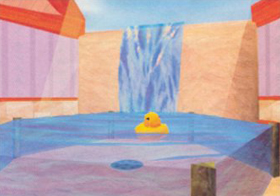
A third, and slightly more disturbing, scenario is taking my first, preferred conclusion in another direction and melding it with elements of the second, rejected possibility. 3D Shooting Game wasn’t a technical demo, true… but instead of being a transitional phase in the game design, its art concept had been finalised (although not cleaned up, obviously - blocky edges would still need rounding off) and we were going to be belaboured with close relatives of the gruesome Emerald Dragon and an unimaginative gaming environment in at least one level after all. The only thing that saved the gamers from this undesirable situation is the possibility that at such an early stage of Saturn development, all the members of the final Team Andromeda might not have been recruited, and they had little grasp of the machine’s full potential. New faces may have joined after the demo was released introduce new ideas that wrested the graphical design away from the course it was set on (Manabu Kusunoki is seen to be a particularly inventive designer, for instance), and once Team Andromeda grew more experienced and confident with the Saturn development kit they realized that they didn’t need to restrict themselves to the boring Emerald Dragon, and could run riot with their imaginations after all.
This situation sounds logical and plausible enough, but I must reject it on the grounds of a lack of evidence. We simply don’t have access to enough information about the precise minutiae of which team member said what and when and why they did it to make a reasonable judgement on this example of intense design micromanagement. It could be true, yet at the present time I must brand it ‘inconclusive’ before more information can come to light. Furthermore, the passages from Gamespot’s article I quoted above again don’t give any indication about disputes over graphical design - every team member seemed consistent on what Panzer Dragoon was visually going to be. It’s true that Sega of America’s Panzer minisite once said “The project went through many changes, and eventually the foundation for what would become Panzer Dragoon was in place” but we don’t know what this foundation was, or what the changes were, or how turbulent they were. Was the foundation full-blown graphics, detailed storyboarding, or merely vague determinations like “let’s make it a gangster game/rail shooter/fantasy RPG with doe-eyed love interest/ren’ai dating sim/sci-fi racer”? We simply don’t know, so we can’t responsibly pursue this line of inquiry any further yet.
To conclude, then, I can confirm that this story has a happy ending, and despite initial worries when we see the offending first images of the game, Panzer Dragoon was never going to be a simple sort of shoot-‘em-up. It might be harrowing to look at those sterile visions of the past that were the screenshots of 3D Shooting Game, but perhaps we should be thankful - that I’ve been able to write an article over nothing but a routine phase of development that may games go through just shows how deep and compelling even the most minute facets of Panzer Dragoon truly are.
Postscript: From Beyond the Grave
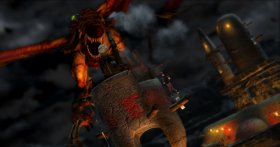
As one final parting comment, scenes from Orta immediately reminded me of the blighted 3D Shooting Game. Players of the latest Panzer game will of course know that some of the game’s prime antagonists were the dragonmares - pure-type monsters that were unprecedented in that they were bent to the Empire’s will - and I can’t help but notice that the dragonmares bear a resemblance to the Emerald Dragon. The dragonmares’ physiques are much more bulked up than Lagi (the dragon that the player controls), approximately similar to the thick haunches of the Emerald Dragon. Additionally, instead of firing Arrows of Light, these dragonmares vomit mucus-balls of energy not too distant from the armament employed by the Emerald Dragon and its rider…
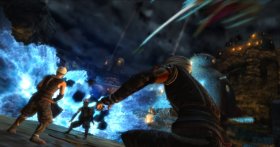
Of course, it’s most likely that these parallels are only coincidental. Yet I find it pleasing to think that the former members of the defunct Team Andromeda that had been moved to SmileBit were imprinting their own, delightfully subtle signature into the game. Despite being tremendous weapons (smashing the Seeker settlement at Yelico Valley almost completely single-handedly), the dragonmares are nonetheless inferior creatures - after all, Lagi and Orta destroy two swarms of them in the game. Perhaps the developers are hearkening back to their own beginnings with the enchanting cycle of Panzer Dragoon reminiscing about the weak, unloved, and unmourned Emerald Dragon…?
Bibliography
- Official Sega Magazine, issues 3-4, 6-10, 20 (March-April 1994, June-October 1994, August 1995). EMAP Images.
- Sega Saturn Magazine, issue 37, (November 1998). EMAP Images
- Retro Gamer, issues 6-7, 12. Live Publishing.
- Green Hill Zone
- Your Spectrum Unofficial Archive
- Starcraft Legacy
- 1up.com
- The Art of Panzer Dragoon
- Gamespot’s History of Panzer Dragoon
- The Will of the Ancients’ screenshot archive
